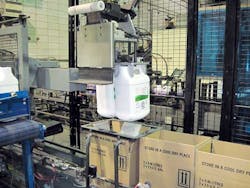Case Packing: Robot Rescues Crew from Heavy Loads
“Sales levels of washer fluid and paint thinners in the large 9.46-liter bottle have amazed us in terms of market demand,” recalls plant manager Lawrence Winter.
Sales climbed by 30 percent in 2009 and have continued to grow. However, manhandling the two-bottle cases weighing nearly 20 kilograms each was taking its toll.
“We realized we were pushing our people on the packaging line too hard, loading the bottles two at a time into cases and then palletizing 39 heavy cases per pallet in three layers of 13 cases each,” Winter relates. “The physically demanding work not only tired our workers, but the neatness of the pallets also began to suffer, and any overhang of the cases can be a sufficient cause for a customer to refuse delivery.”
Recochem began to investigate automated solutions for case packing and palletizing. After trying several semi-automated systems with mixed results, Rechochem Western Operations Manager Richard Wu ultimately settled on a fully-automated solution in the form of a model EPL80 palletizing robot from West Carrolton, Ohio-based Motoman, Inc.
With an 80-in. (2,032-mm) reach and 176-lb. (79.8-kg) payload capacity, the compact five-axis EPL80 was designed with a wide, 360-degree work envelope and a minimal footprint. It did not require any more floor space than the 10- x 25-ft. workspace occupied by the manual packing lines it replaced, while its customized end-of-arm tooling enabled the robot to both pack the cases and palletize them at high speeds.
Elevated Delivery
Installed in June of 2009 at a total project cost well within the budgeted $182,000—including installation of a custom-engineered conveyor line—the system has garnered rave reviews. “Compared to conventional case-packing and palletizing lines, the robotic line requires minimal maintenance and occupies relatively little floor space,” notes Winter. He explains that the new conveyor was designed specifically to allow filled cases to flow back into the workcell from an elevated space a foot or so above from where they exit the filling room.
“This is accomplished by conveying the bottles onto a small elevating platform that lifts the bottles up 12 inches and deposits them onto a channelizing conveyor. A diverter fills two lanes simultaneously, feeding the bottles side-by-side down the channelizing conveyor and into the packaging cell,” Winter explains.
Once sensors signal the robot controller that bottles are in position for pick-up, the robot grabs the bottles two at a time and drops them into a case. Filled cases then convey underneath the channelizing conveyor through a top-sealing operation and make a U-turn back into the robotic cell on the opposite side of the case-packing station so that the robot can start palletizing them. The end-of-arm tool allows it to switch from case packing to palletizing without a tooling change.
When the cell control senses that a sealed case is ready for palletizing, explains Winter, the robot temporarily stops case packing and moves toward filled cases on the opposite side of the cell. “All the robot actions are completely directed and guided by sensors throughout the conveying line,” he says.
“The robot has all but eliminated any overhang issues, while dramatically increasing our throughput,” Winter states. “We’re running the cell at 10 bottles per minute, or 35 percent faster than when we packed and palletized manually. And we went from three operators required to case pack and palletize on that line to one operator who only has to monitor cell activity and keep the case erector filled with flat cartons.”
He adds that the other two operators, who were earlier reassigned to the line from other areas of the plant when volume picked up, were able to return to their original, less-physically demanding work areas (and most likely breathed a sigh of relief).
June 2011, Related Feature – Will Robots Ever Replace Humans?
To read the feature article, visit http://www.automationworld.com/feature-8860

